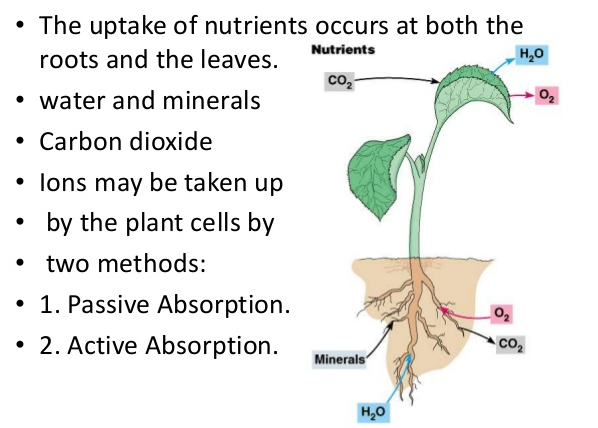Humidity and temperature have an effect on both forms of absorption in a plant’s environment. These aspects are more crucial to the absorption rate. The physiology of plants relies heavily on both active and passive absorption.
Difference between Active and Passive Water Absorption
| Sl. No. | Active Absorption | Passive Absorption |
|---|---|---|
| 1 | Active absorption of water utilizes metabolic energy | Passive absorption utilizes solar energy |
| 2 | Water is absorbed ‘by’ the roots (Roots have an active role) | Water is absorbed ‘through’ the roots (Roots have only a passive role) |
| 3 | The water is absorbed by osmosis and non-osmosis method along or against the DPD gradient | Water is absorbed as a result of the tension created by the transpiration pull |
| 4 | Involves symplast * (protoplast) movement of water | It involves apoplast * (nonliving part) movement through free spaces |
| 5 | Absorption is independent of transpiration | Absorption is dependent on transpiration |
| 6 | Usually, takes place when the water level is high in the soil | Usually, takes place when the water level is low in the soil |
| 7 | Occur only in the presence of roots | Occurs even in the absence of roots |
| 8 | Produce positive pressure in the xylem canals | Produce negative pressure in the xylem canals |
| 9 | The absorption rate is comparatively slow | The absorption rate is comparatively fast |
| 10 | Quickly inhibited by metabolic inhibitors or toxins | Metabolic inhibitors or toxins do not have an immediate effect on passive absorption |
| 11 | Two types: (1) Active osmotic water absorption and (2) Active non-osmotic water absorption | No such classification in passive water absorption |

The root’s only job is to soak up everything it can. In order to make up for the water that is being lost at the blade’s tip, plants absorb more water as transpiration progresses. The plant passively absorbs most of the water that comes into it. Similar to diffusion, negative transfer does not need any additional energy for the molecules to move from higher to lower concentrations. Root cells are located in the soil and are the primary entry points for water into the plant through passive absorption. Minerals and nutrients are taken in with the water.
Active Absorption of water
With the support of adenosine triphosphate, the roots formed by the root’s respiration actively absorb water. This process, in which root cells participate actively, is known as active absorption. Renner claims that just 4% of a plant’s total water absorption is active, and that this only happens under conditions of minimal transpiration and adequate water. Two different models of active absorption are proposed: active permeable water and active impermeable water. With this technique, no energy is used.
There has been a natural rise in interest over the last 30 years in how plant cells take in minerals. From a practical agricultural standpoint, the absorption responses are linked to issues of toxicity and nutrition in soil-grown crop production.
Water Absorption in Animal Cells
Many ideas and processes have been presented over the last several decades to explain mineral absorption by plant and animal cells. These processes may be loosely categorized into two groups: (a)those that view the process in terms of unique physical or electrical features of cellular membranes; and (b)those that hypothesize areas with unique chemical properties.
As things are right now, no widely acknowledged mechanism for ion absorption has been presented. Nonetheless, the process’s defining characteristics have been defined to a satisfactory degree for a number of plant tissues. Given our privileged vantage point, we are in a good position to judge hypotheses on their merits. More precisely, the following universally observable facts about the process must be compatible with any explanation of ion absorption by roots:
ION PDF Download
The ion adsorption process requires metabolic activity by the plant (isotopic exchanges excepted). Onion accumulation occurs in the absence of respiration and other activities such as protein synthesis, etc. In general, the process is an attribute of tissues capable of growth although not invar.
You Might Also Like:
Originally posted on 11/09/2023 @ 10:00 am